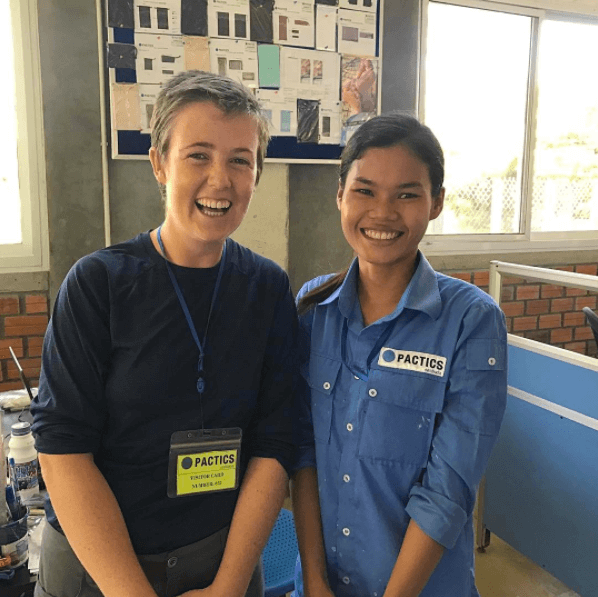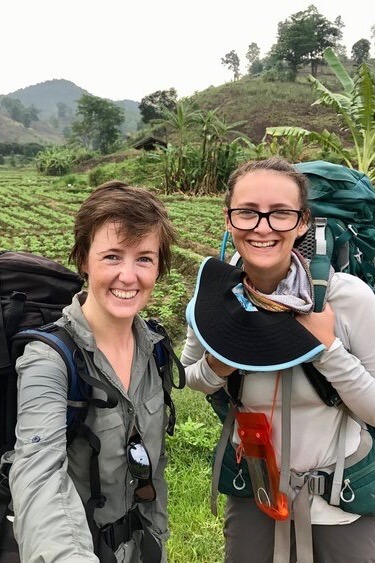Everyone, meet your newest ethical fashion related obsession: Walk Sew Good. Made up of two smart and sassy women, Megan and Gab, team Walk Sew Good is currently walking across southeast Asia to gather positive stories about how your ethically-made clothes are produced and the affect that ethical business practices have on the people who make your clothes.
I was lucky enough to connect with Megan and Gab over Skype, where we proceeded to have an hour and a half conversation that “felt like 30 minutes”. We laughed, we talked about deep and difficult questions, and shared our thoughts on the future of the ethical fashion industry.
First, I wanted to know what sparked the Walk Sew Good project. Megan, the initiator, had become passionate about ethical fashion after being enlightened to the poor treatment of garment workers. Recently, she decided that she was not doing enough of what she was passionate about. Inspired by an article that she read about a man who walked across the world, Megan cooked up the idea to walk across southeast Asia to promote ethical fashion and tell stories that matter. In Megan’s words, she “dragged Gab along”- but it’s apparent that Gab’s own interest in ethical fashion and social justice makes her the perfect partner for the job.
So far, Megan and Gab have been on the road for several months, and have already managed to visit an impressive number of factories and workshops, like Dorsu in Cambodia (featured below)! I love that Megan and Gab have chosen video as a medium to tell the stories of the people that they meet, because it’s the next best thing to visiting and having a face-to-face conversation on your own.
I asked Megan and Gab if they had a favorite place that they’d visited, or if there was a place that stood out in their minds, as a good example of what fair manufacturing should look like. Pactics in Cambodia was a favorite with both, a large-scale manufacturer that mostly deals in active wear and those microfiber cloths that you’d use to clean your glasses or electronics. This factory is able to employ around 300 employees, paying a fair living wage. The facility boasts a library, green space, and solar power, and includes perks and benefits for their employees, even down to providing helmets for the workers who commute by motorbike.
My favorite story from Pactics was regarding their advocacy for their workers. The factory recently agreed to send several female workers to university to become engineers for the factory. They didn’t take “no” for an answer when told that those workers couldn’t enroll in the engineering program because they were girls, and the workers were able to get their education and move up in their careers.
Beyond just talking about the places the Walk Sew Good girls have visited, I wanted to pick their brains on what they’ve learned thus far on their journey. I drew out a few main points from our conversation that I thought would be interesting to you, dear readers:
There are no easy answers.
We simplify “ethical fashion” so much when we talk about it -“why can’t garment manufacturing facilities just pay everyone fair wages?”- When it’s really much more complicated than that. A “fair wage” in one area might not be a fair wage in another, factories are often struggling to get the companies that send them orders to pay high enough per piece the pay a decent wage, while still attempting to not lose the huge contracts that employ their workers to a competing factory. When we discuss ethical fashion, we can’t be too wide-eyed and idealistic, we must consider the realities of how the business world works!
Wages are… complicated.
I asked Megan and Gab if, in their travels, they’d been able to gather a lot of specific information on wages. I was curious about the actual dollar amount that workers in the ethical fashion sphere in Southeast Asia are making, and whether it is all across the board or somewhat consistent. As I suspected, it’s sort of all over the place. Similar to the Philippines, many countries have two seperate “living wages”- one for the city and one for the countryside. We talked about whether “fair trade” should standardize wages- a tough question with many pros and cons to consider. As Gab stated, “If I was being paid less than my counterparts for the same job, I wouldn’t feel that that was fair”- but it is true that the cost of living is drastically lower in the country than in the city. Megan offered, “I don’t know if there should be a set standard amount because it makes it difficult to actually set fair wages in different situations and locations. I think that the questions that should be asked are; ‘Is this enough to break the cycle of poverty, pay for food and housing comfortably, and allow for growth in the future?'”.
Let’s stop pretending every ethical fashion company is perfect.
During our conversation, Megan said something that really resonated with me: “What I think is missing in the ethical fashion world is honesty- not pretending everything is perfect. It’s actually so hard to get information from brands. They may be ethical in some ways but that doesn’t give them a free pass to withhold information about the other areas they’re not being super sustainable in”. I think that many ethical companies are intimidated by sharing honest details about wages, production, etc because they feel pressure to be perfect. Let’s acknowledge that 100% ethical is rarely a thing- a company may use hand-dyed, hand-woven, eco-friendly fabric but also package each garment in plastic and use zippers that come from a sweatshop-type factory in China. Maybe then, we can start to have open dialogues about what “ethical fashion” really looks like!
Thanks so much, Megan and Gab, for taking the time to chat about your project and the future of ethical fashion with me!
For more insights and inspiration + beautiful, positive stories, follow the Walk Sew Good project:
Web | Instagram | Facebook | You Tube |
All photos in this post are courtesy of Walk Sew Good’s Instagram account



0 comments